Abstract
Partial shading conditions (PSC) have negative effects on the operation of photovoltaic (PV) systems. In this paper, a PV array reconfiguration method is developed to minimize power losses of PV arrays under partial shading conditions. The proposed reconfiguration method is based on equalizing the reduction of the short-circuit current of the PV modules in the PV array. Eight state-of-the-art Convolutional Neural Network models are employed to estimate the effect of shading on the short-circuit current of a PV module. These models include LeNet-5, AlexNet, VGG 11, VGG 19, Inception V3, ResNet 18, ResNet 34, and ResNet 50. Among eight models, the VGG 19 achieves the best accuracy on 1842 sample images. Therefore, this model is used to estimate the ratio of the actual short-circuit current and the estimated short-circuit current in four studied shading scenarios. This ratio decides the switching rule between PV modules throughout the PV array under PSC. A experimental PV array shows that the proposed reconfiguration method improves the output power from 5.81% to 25.19% in four shading patterns. Accordingly, the power losses are reduced from 1.32% to 13.75%. The power improvement and the reduction of power losses of the proposed dynamic PV array reconfiguration system under four case studies demonstrates its effectiveness in addressing the effects of PSC on the PV array.
1. Introduction
Renewable energy resources (RES) have burgeoned globally in the context of the dramatic increase in energy demand and the urgent command to reduce greenhouse emissions. Among the RES, photovoltaic (PV) systems have become an important option due to their cost advantage compared to other resources, such as wind turbines. According to a report from the IEA 2021 [1], at the end of 2020, the total cumulative installed capacity of PV reached above 760.4 GWdc globals. However, partial shading conditions (PSC) detrimentally affect the operation of PV systems. The PSC causes the PV array to operate under heterogeneous irradiance, which leads to the power loss of the whole system and the degradation of the PV panels. In reality, PSC frequently happens, either from variable objects, such as moving clouds or fixed objects, such as nearby rooftops, dust, snow, or leaves. Figure 1a shows that the dust on the PV panels is distributed haphazardly on their surface. This phenomenon typically happens for PV systems near factories. In these locations, PV panels near the factory are thickly covered by dust, whereas far-away PV panels are less affected. Therefore, the PV arrays are covered by uneven dust, which makes the photon flux that the PV modules receive heterogeneously. In Figure 1b, the nearby roof or overgrown trees can be sources of PSC.

Figure 1.
PSC examples. (a) Dust. (b) Nearby rooftop.
Many techniques have been proposed to address the influence of PSC on the operation of PV arrays, such as adopting the distributed maximum power point trackers (MPPT) [2] or the multi-level inverters [3]. Though these models could reduce the power losses of the PV array under PSC, the additional maximum power point trackers or inverters highly increases the investment. One prominent technique that has been extensively studied to tackle the PSC is the PV array reconfiguration (PVAR). PVAR aims at changing the distribution of irradiance on the surfaces of PV panels. There are two categories in PVAR: static reconfiguration and dynamic reconfiguration [4]. Static PVAR alters the electrical connections of the PV modules in the PV array to form specific configurations. Ref. [5] minimizes the power losses and limits the wiring losses employing repositioning method. However, the strength of this method is limited under certain PSC since the PV array is one-time reconfigured. In [6], a novel shade dispersion method to improve the output power of the PV array under PSC is proposed. The proposed model is validated by simulation software and experiments by using various evaluation metrics (global maximum power point, mislead power, percent output, efficiency, fill factor, and percent power enhancement). Ref. [7] develop the optimal SuDoKu configuration, which shows the improvement compared to the original SuDoKu configuration in terms of minimizing power losses and line losses. Ref. [8] utilizes the Magic Square Puzzle to enhance the output power of the PV array under PSC. The performance of the Magic Square Puzzle is compared with other configurations, including Total-cross-tied (TCT), Series parallel—TCT (SP—TCT), Bridge link (BL)—TCT, BL—Honey comb (HC), and Mishra configuration [9]. Ref. [10] enhances the harvesting capability of the PV array under PSC using AdDoKu method. However, the line losses have not addressed in this study. Overall, the static configurations have proven their abilities in minimizing power losses under common shading patterns. However, this approach only alters the connections of PV modules one-time and remains that configuration during the operation. Thus, its strength is limited under certain PSC. Studies on the static PVAR are demonstrated in Table 1. Dynamic PVAR reallocates irradiance on PV array by changing terminal connections of PV modules. This approach changes the connections of PV modules during the operation of PV arrays, therefore, it requires the data acquisition system and the switching board. Recently, Dynamic PVAR has been intensively studied due to its adaptive capability to different PSC patterns. Ref. [11] employs three population-based algorithms, which are Flow Regime Algorithm (FRA), Social Mimic Optimization (SMO), and Rao optimization algorithm, to counteract PSC on the PV array. This study simulates a daily scenario of moving shadows, yet, the shadow scenarios are simple. Ref. [12] proposes the Democratic political algorithm to obtain the optimal configuration for the PV array utilizing wide range of array size and shadow patterns. Ref. [13] analyzes the Adaptive method and Logic algorithm in mitigating the number of measurements and switches. Ref. [14] uses Modified Couple Matching method to estimate PSC. Ref. [15] proposes Ancient Chinese Magic Square-based reconfiguration, which is validated on a real-time experimental system. Ref. [16] diminishes the effect of PSC by utilizing current injection converters to boost current of the PV array. Ref. [17] applies the reconfiguration strategy to a large-scale PV plant, however, the operation of the switching matrix is not mentioned. Ref. [18] uses the Genetic algorithm to determine the optimal configuration of the PV array under PSC. The execution time is mentioned clearly along with the PV size. The above-reviewed studies of the dynamic PV array reconfiguration are summarized in Table 2. Because the dynamic PV array reconfiguration can adapt with the continuous changes of the PSC, it is further studied in this paper.

Table 1.
Literature review on static reconfiguration category.

Table 2.
Literature review about dynamic reconfiguration category.
In designing the Dynamic PVAR, establishing the data acquisition system is a challenging task since it requires the installation of numerous expensive meteorological sensors and electrical instruments for each PV module. Studies [20,21] extract irradiance values from the measured current and voltage based on a simplified characterized equation of the PV module. However, measuring the current of each PV module in a string of PV modules is arduous since the current of a string is limited to the current of the most shaded PV module. With the recent advancements in Computer Vision, such as image classification, and object detection, it is a promising approach for estimating the operating condition of the PV module. Ref. [22] determines the power losses due to partial shading from visible spectrum RGB images based on the Region-based Convolutional Neural Network (CNN). Ref. [23] proposes a method to predict anomaly events happening on PV modules, such as soiling, shadowing, hot spots, and cracking. This method employs a residual network combined with an ensemble technique to process infrared radiation images. Ref. [24] proposes a model to monitor conditions and diagnose faults of the PV modules using a U-Net neural network and three machine learning classifiers (Decision tree, K-Nearest Neighbours algorithm, and Support-vector machine).
Although many Dynamic PVAR strategies have been proposed, experimental studies on Dynamic PVAR are scarce. The reason is that establishing the Dynamic PVAR system involves challenging tasks, such as designing the data acquisition system and the switching matrix. Ref. [20] builds the electric array reconfiguration on a 1.65 kWp grid-connected PV system. This reconfiguration system based on irradiance equalization has proven its effectiveness. The switching matrix is created based on relays. The experimental results demonstrate that the output power of the PV array with the electric array reconfiguration is 3% better than the one of the static PV array. Ref. [25] sets up a system with two PV panels to change from series to parallel connections. The switching board has three relays controlled by the Fuzzy logic program. Though this system has shown its effectiveness under PSC, the system is oversimplified. Therefore, the reconfiguration strategy has not fully proven its superiority in counteracting the influence of PSC. Ref. [26] establishes a PV array with the Arduino micro-controller, a commercial relay module consisting of 24 double-pole double-throw relays. The reconfiguration program is designed for repeated shading, which can store the solution for similar patterns to reduce processing time for the next time. Ref. [27] shows that the TCT configuration is better than the SP configuration under PSC. So, this study designs an experiment on a PV array. The investigated system includes three main components. The first component is nine PV panels with relays to change connections between PV panels. The second component is the Arduino-based control unit and the data acquisition system. The final component is the user end operating system, which is used to switch from SP configuration to TCT configuration when PSC is detected.
The above literature review shows the difficulties and limitations in measuring the irradiance to reconfigure the PV array under PSC. To the best of our knowledge, there was no previous work employing the image processing to solve the problem of the PV array reconfiguration. In this study, instead of using the irradiance to identify the optimal configuration for the PV array under PSC, the effect of PSC on the short-circuit current of the PV module is used as an indicator to decide the optimal configuration for the PV array under PSC. The short-circuit current is estimated with the assumption that the PV module is not shaded. The ratio between the measured short-circuit current and the estimated short-circuit current is employed as a metric to determine the optimal PV configuration under PSC. The short-circuit current of the PV array considering the effect of PSC is estimated by eight CNN-based models using the images of the PV array. An experiment is established to validate the efficacy of the proposed Dynamic PVAR under PSC. The switching matrix is based on a relay module and the Arduino Uno-based controller. Three main contributions could be folded as follows:
- Instead of using the irradiance equalization method, a method based on equalizing the effect of PSC on the short-circuit current of each row of the PV array is proposed. The ratio of the measured short-circuit current to the estimated short-circuit current is used as a metric to decide the optimal configuration for the PV array under PSC. Compared with the conventional irradiance equalization method, this method eliminates the expensive pyranometers and represents the actual irradiance on the PV module considering the shading effect.
- CNN-based models are proposed to estimate the ratio of the two short circuit currents under PSC. The proposed models employ the information of the short-circuit current and surface’s irradiance to create labels for the CNN models.
- The experiment is set up on a PV array to validate the proposed Dynamic PVAR framework. The experimental results show the effectiveness of the proposed short-circuit-current estimating model and the proposed reconfiguration framework.
The remaining parts of this paper are organized as follows: Section 2 presents the proposed Dynamic PVAR utilizing equalization of the ratio of two short-circuit currents under PSC. Section 3 demonstrates the proposed CNN-based method to estimate the short-circuit current. In Section 4, the experimental investigation for the proposed Dynamic PVAR under PSC is developed. Section 5 is devoted for the results and discussions. Conclusions are drawn in Section 6.
2. Proposed Dynamic PV Array Reconfiguration Based on Equalizing Effect of Partial Shading Conditions on Short-Circuit Current
In practical applications, to augment the output voltage and output current of the PV system, many PV modules are connected to each other to form the PV array. In this study, the Dynamic PVAR is investigated on the TCT configuration since this configuration is proven to be the most efficient under PSC [28]. Figure 2a depicts a PV array with the TCT configuration, which consists of 9 cross-tied strings, and each string has 9 series-connected PV modules. Thanks to the dense connections between PV modules, the TCT configuration can change the connections of the PV modules throughout the PV array in various ways. The output voltage of a TCT PV array is calculated by:
where [V] is the output voltage of the PV array, and [V] is the voltage of the PV modules at the row. j denotes the index of the column of the PV array. The output current of the PV array ( [A]) is the summation of the parallel-connected PV modules, which is computed by applying Kirchhoff’s Current Law for each node:
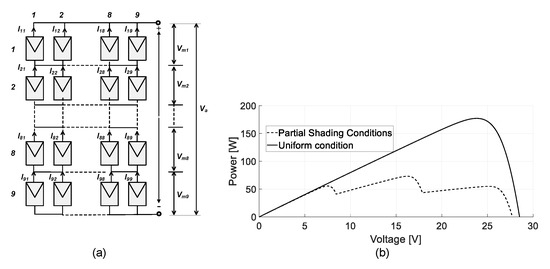
Figure 2.
(a) TCT configuration. (b) P–V characteristics of PV module under uniform condition and PSC.
Since the performance of the PV modules varies upon the irradiance condition, the output power-voltage (P–V) characteristics of PV modules in the PV array are heterogeneous. With the intervention of the bypass diodes, the output P–V characteristic of the PV array appears in many local peaks (Figure 2b). To mitigate the irradiance heterogeneity on the PV array, the Dynamic PVAR changes the terminals of connections of the PV modules so that the irradiance is evenly distributed on rows of PV modules. A conventional Dynamic PVAR framework consists of three main steps: irradiance measurement/estimation, determination of the optimal configuration, and switching. In the literature, many studies based on the irradiance equalization method are proposed to evaluate the level of similarity of irradiance on the rows of the PV array. Although the irradiance equalization method is theoretically straightforward to evaluate the even distribution of PSC on the PV array, measuring irradiance for each PV module is expensive in reality. In addition, the measured irradiance is only representative for the area that places the pyranometer, therefore, it is not the best metric to represent the effect of the PSC on the whole PV module. In this paper, another metric is used to evaluate the even distribution of the shade on the PV array. It is noteworthy to mention that the irradiance is proportional to the short-circuit current of the PV module [19]:
where G is the irradiance on the module at the measurement time, is the irradiance on the module at the standard test condition ( = 1000 ). , are the short-circuit current of the PV module at the measurement time and at the STC, respectively. In this study, the ratio between the measured short-circuit current to the estimated short-circuit current is estimated to evaluates the effect of PSC. For an PV array, the ratio of the short-circuit current for the row is calculated as the summation of the ratio of the short-circuit currents of the modules in that row:
Then, the mean value of the ratio of two short-circuit currents of the PV array is computed as follows:
The mean value of the deviation of the ratios of short-circuit currents of m rows and the mean ratio of the short-circuit currents of the PV array is computed as:
The objective function of the proposed reconfiguration algorithm is to minimize . In this paper, the Best-worst algorithm [29] is utilized for obtaining the optimal PV configuration due to its fast computation. This merit aids the reconfiguration system in responding faster to PSC.
3. Proposed CNN-Based Short-Circuit Current Estimation Models
The CNN is widely-used for visual applications, such as image classification and object detection, as the CNN can automatically detect and learn important features of the objects through its layers. Instead of creating full connections between neurons in consecutive layers, each layer in a CNN is partially connected to a limited region called the receptive field of the neuron [30]. This helps the CNN shrink the number of parameters of the network, avoid overfitting, and reduce the computation. There are three main types of layers in a CNN structure (Figure 3). The first and the core building block is the convolutional (Conv) layer, which is generally expressed as [31]:
where is the output image, is the input image, w is the filter kernel, and * is the convolutional operator. Every neuron in the filter kernel is considered by and . It is common to have the rectified linear unit (ReLU), which plays as an activation function, after the Conv layer. The second type of layer is the Pooling layer (POOL). A POOL layer is periodically inserted between successive Conv layers to downsample the input images. This aims at gradually reducing the spatial number of parameters and computation in the network, thus avoiding overfitting. The third type of layer is the fully connected (FC) block. Neurons in an FC layer are fully connected to all activations in the previous layer. Their activations could be calculated with a matrix multiplication by a bias offset. Three above-presented layers, including Conv, POOL, and FC, are stacked together to form entire CNN architecture. A typical CNN architecture consists of a few CONV-ReLU layers, then followed by POOL layers, and repeats this pattern until the image gets smaller and smaller (the network gets deeper and deeper). At the last layers, it is common to stack FC layers. The last FC layer holds the output. The most common CNN architecture can be described as:
where * denotes repetition, the denotes an optimal pooling layer. In this paper, eight well-known CNN models (LeNet-5, AlexNet, VGG-11, VGG-19, Inception V3, ResNet-18, ResNet-34, and ResNet-50) are utilized. These eight networks have proven their abilities in many practical applications and created a major breakthrough in the field of Computer Vision.

Figure 3.
Typical CNN architecture.
Figure 4 presents the process of the proposed models to estimate the ratio of the two short-circuit currents. This process has three main steps. The first step is to collect and pre-process the data for the training process. The collected images will be segmented into a homogeneous format. The second step is to express the values of irradiance, and the short-circuit current as the ratio between the actual and the estimated short-circuit current. This value is used as a label for its corresponding image. The final step is to estimate the ratio between the actual and the estimated short-circuit current for the new images. The preprocessed images and their labels are fed into eight CNN models to complete the estimation task.
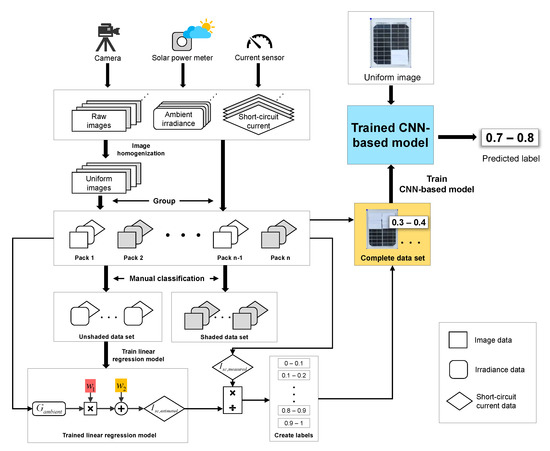
Figure 4.
Process of proposed short-circuit current estimation method.
3.1. Data Acquisition and Preprocessing
To prepare data for the training set, one PV module is set up under PSC as in Figure 5. To emulate the PSC, paper boards are used. A camera is installed on a fixed tripod to capture the images of the PV module. This ensures that the images are captured in the same format. 1842 images are captured by a camera with a resolution of 13 megapixels under different irradiance conditions. In addition, the ambient irradiance and the short-circuit current of the PV module at that time are also recorded. Before inputting into the CNN model, it is necessary to extract the region of interest (ROI) of the PV module within each image and homogenize the ROI into a uniform format. In this study, we use the VGG Image Annotator [32] to extract the bounding box surrounding the PV module and homogenize the images.
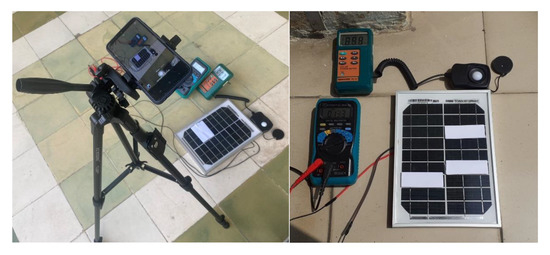
Figure 5.
Data collection for training set.
3.2. Relationship between Actual and Estimated Short-Circuit Currents
Instead of feeding the irradiance and actual short-circuit current directly to the CNN models, these data are used to express the relationship between the actual short circuit current (the PV is shaded) and the estimated short-circuit current with the assumption that the PV module is unshaded. The preprocessed images are categorized into shaded and unshaded images. The corresponding values of the short-circuit current and irradiance of the unshaded images are fitted into a linear regression model. The linear regression equation is expressed in Figure 6. From this equation, the short-circuit current of a shaded image is estimated with the assumption that the PV module is unshaded as follows:
where is the estimated short-circuit current of the PV array. G is the irradiance. The ratio of actual short-circuit current to the estimated short-circuit current of the PV module is calculated as follows:
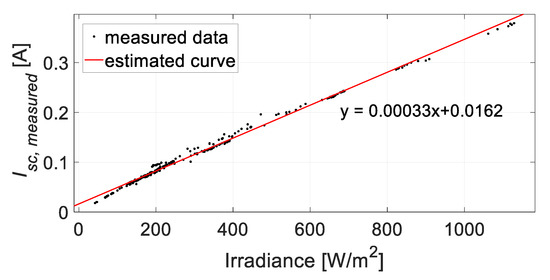
Figure 6.
Linear regression of short-circuit current and irradiance of unshaded images.
This metric expresses the effect of PSC in reducing the short-circuit current value. These ratio values are classified into 10 deciles from 0 to 1 with the step of 0.1. These deciles are used as corresponding labels for their images to input into the CNN models.
3.3. Estimating Ratio of Two Short-Circuit Currents by CNN Models
The uniform images of PV modules in the training set with their corresponding labels are fed into the CNN models to complete the training phase. The uniform images of the testing set are inputted to the trained CNN models to estimate the ratio of two short-circuit currents.
Eight chosen CNN models are state-of-the-art architectures in the field of Computer Vision. The mainstream of the CNN models is to develop deeper networks from a few layers to dozens and hundreds of layers, which are capable of exploring more features of an image. Architectures of the eight studied CNN models are briefly presented in chronological order as follows.
3.3.1. LeNet-5 Architecture [33]
LeNet-5 is comprised of a Conv encoder including two Conv layers, which is followed by a dense block including three FC layers. The basic units in each Conv block are a Conv layer, a sigmoid activation function, and an average pooling operation. This original architecture can be improved by using the ReLU and the max-pooling instead of the sigmoid function and the average-pooling.
3.3.2. AlexNet Architecture [34]
The architecture of AlexNet is very similar to the one of the LeNet-5, only deeper, bigger, and has more Conv layers stacked on top of each other.
3.3.3. VGG Architecture [35]
The VGGNet consists of Conv layers, POOL layers, and FC layers. The Conv layer is comprised of the stacked VGG blocks (Figure 7). The notation “ Conv, pad 1” in Figure 7 means that the layer has a filter with stride 1 and same padding. The primary contribution of the VGG is that it proves the depth of the network makes an important contribution to network performance.
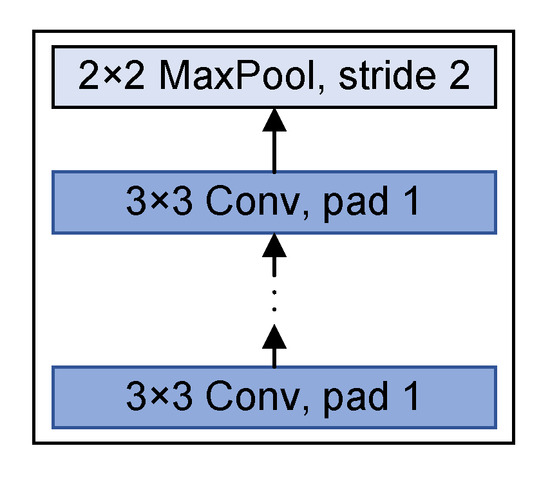
Figure 7.
VGG module.
3.3.4. Inception V3 Architecture [36]
Inception V3 is the improved version of the GoogleNet [37]. The most distinctive feature of the Inception V3 network is the development of an inception module that substantially reduces the number of parameters in the network (4M compared to AlexNet with 60M). The inception block is depicted as Figure 8. The notation “ Conv, pad 2” means that the layer employs a filter with stride 1 and the same padding. Since all layers in the inception module use a stride of 1 and the same padding, their inputs have the same heights and widths. This allows concatenating all the outputs in the depth concatenation layer.

Figure 8.
Inception module.
3.3.5. ResNet Architecture [38]
One notorious problem of a deep network is that the performance of the network degrades after a certain depth. This is explained by the gradient vanishing/exploding phenomenon. During the back-propagation step from the final layer to the first layer, the weight of each layer is multiplied, which makes the gradient quickly decrease to zero or approach a massive value. This is addressed by a recent residual network by inserting a skipping connection in the network. Figure 9a shows one ResNet block with its main components. Each ResNet plain block contains two convolutions, a batch norm, and a ReLU function. Its counterpart (Figure 9b) has a skip connection to transfer information from the input block to the output block while preventing the vanishing/exploding phenomenon happens. The architecture of ResNet 18 is represented in Figure 9c. ResNet 34 and ResNet 50 have the same pattern as the one of ResNet 18 but only have more stacked ResNet blocks.
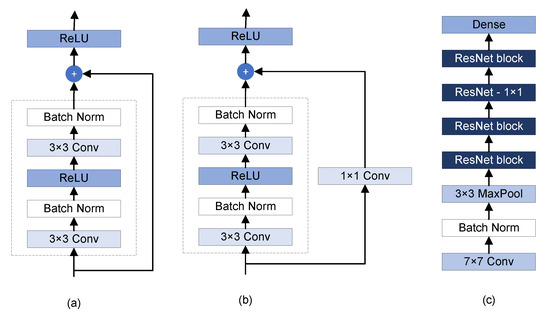
Figure 9.
ResNet Architecture: (a) ResNet block. (b) ResNet Block with 1 × 1 Conv (ResNet − 1 × 1). (c) ResNet-18 Network.
Eight CNN models are performed with various types of cross-validation, the number of epochs, batch sizes, and learning rates. The most appropriate features are selected for the estimation task of this paper. Features of eight CNN models are shown in Table 3.

Table 3.
Features of eight CNN models.
4. Experimental Setup
In the training phase, we used a camera to capture images of a sample PV module and measured the corresponding ambient irradiance by a solar power meter and short-circuit currents by a multimeter. These data are used to train the regression model to create the labels for corresponding image data. After that, the labels and image data are employed to train the CNN models. The training phase takes a longer time to reach the best performance. The training phase takes about one second and a few minutes for the regression model and CNN models, respectively. The trained CNN models are utilized for real-time estimation of the ratio of the short-circuit currents.
Figure 10 shows the block diagram of the proposed Dynamic PVAR system for realtime reconfiguration. The PV array includes 4 PV modules configured in the TCT topology. Terminal connections of PV modules are connected to 8 single-pole double-throw relays, whose statuses (open/close) are controlled by the reconfiguration algorithm programmed on the Arduino Uno. The PV array is connected to an electronic load to consume the energy generated by the PV array. The current and voltage of the PV array are measured and saved by the AC/DC clamp sensor HIOKI 9693-90 and the power quality analyzer HIOKI PW3198. The current and voltage data of the PV array are transmitted to the cloud drive. In addition, the camera captures the images of the PV array, and then these imagery data are also sent to the cloud drive. These two sources of data are imported to the proposed Dynamic PVAR framework in the control and monitoring room. After less than one second, the corresponding labels are created and inputted into the reconfiguration algorithm to identify the optimal configuration. Finally, the control signals are transmitted to the the Arduino Uno to change the connections of the PV array via ESP 32 with the master-slave topology.
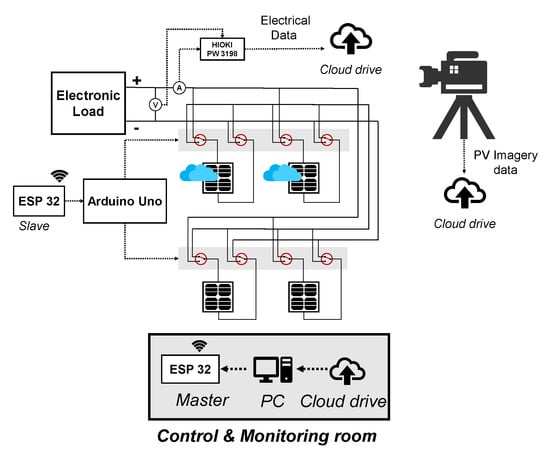
Figure 10.
Block diagram of studied system.
It is also necessary to note that the images taken from the training phase are from a single PV module, whereas the whole 2 × 2 PV array is used in the real-time operation phase. Therefore, we must divide the testing images into four segments corresponding with four PV modules. These raw images are extracted to get the surrounding box of the PV module by using the perspective correction method.
Figure 11 shows the image of the investigated system. This system includes one reconfigurable PV array, one solar power meter, an electronic load, a data recorder, a camera, an Arduino-based control board equipped with a battery supplier, a clamp current transformer, and a set of 8 relays. The specifications and roles of components are presented in Table 4.
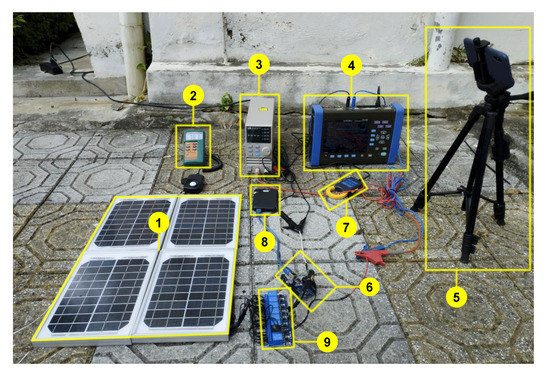
Figure 11.
Experimental system. (1. Reconfigurable array; 2. Solar power meter; 3. Electronic load; 4. Data logger; 5. Camera; 6. Micro controller; 7. Clamp sensor; 8. Battery supplier; 9. Switching board).

Table 4.
Specifications and functions of components in experiment.
5. Results and Discussion
5.1. Case Studies and Evaluation Metrics
To choose the best CNN-based models estimating the ratio of two short-circuit currents, eight networks are validated on 1842 sample images. After that, the best CNN model is employed to estimate the ratio of short-circuit currents in four case studies in Figure 12. The estimated ratio of two short-circuit currents is calculated by the mean of the decile. The estimated ratios of two short-circuit currents are used to determine the switching rules for the PV array. The Mean absolute percentage error (MAPE) and Root mean square error (RMSE) are used to evaluate the performance of the short-circuit current estimation:
where and are the estimated and actual ratio of two short-circuit currents. N is the number of images. The accuracy of the estimation on each set (training set and testing set) is defined as the number of the right estimation of the mean value of the classification range on the number of images in each data set.

Figure 12.
Four case studies: (a) Case 1. (b) Case 2. (c) Case 3. (d) Case 4.
To validate the efficacy of the proposed Dynamic PVAR in reducing power loss under PSC, two investigations are completed. First, the P–V curves of the PV array without PSC, with PSC and before reconfiguration, and with PSC and after reconfiguration are recorded and compared with each other. The P–V curves are created by changing the load from 0 to of the PV array and recording the corresponding current values. Three metrics, namely global maximum power point (GMPP), power improvement, and reduction of power losses, are utilized. GMPP is the highest maximum power point on the P–V curve. Power improvement [%] and reduction of the power losses [%] are computed by (13) and (14), respectively.
and are the maximum power of the PV array under PSC before and after reconfiguration, respectively.
is the maximum power of the PV array without PSC.
5.2. Results and Discussion
5.2.1. Estimation of Ratio of Short-Circuit Currents
Figure 13 shows the prediction of the ratio of the actual short-circuit current and the estimated short-circuit current of eight models for the training (Figure 13a) and the testing sets (Figure 13b). The predicted curves of seven models from the AlexNet to the ResNet-50 have very similar patterns and agree with the actual curve except at the values that exceed one. The actual curve has several values that are greater than one, which is caused by the error between the estimated short-circuit current and the measured short-circuit current. The predicted curve of the LeNet-5 deviates from the actual curve significantly. This is comprehensible since the LeNet-5 model has the lowest number of layers among eight networks. In the testing set, it also happens similarly to the training set. The estimation results of the LeNet-5 are different from the actual curve in the low values of the ratio of two short-circuit currents. The other seven models have very close estimation patterns and highly agree with the actual curve. The MAPE and RMSE of eight models in estimating the ratio of two short-circuit currents are shown in Table 5. The VGG-19 model has the lowest MAPE and RMSE in estimating the ratio of two short-circuit currents, while the LeNet-5 has the highest MAPE and RMSE. Three ResNet models have the lowest MAPE and RMSE in the training phase.

Figure 13.
Prediction of ratio of short-circuit currents: (a) Training set. (b) Testing set.

Table 5.
MAPE and RMSE of eight model in estimating ratio of short-circuit currents.
Figure 14 illustrates the accuracy versus the number of training epochs of eight models on the training and testing sets. The LeNet-5 has the lowest accuracy among the eight models in both training and testing sets. The other seven models achieve good accuracy on the training and testing sets.
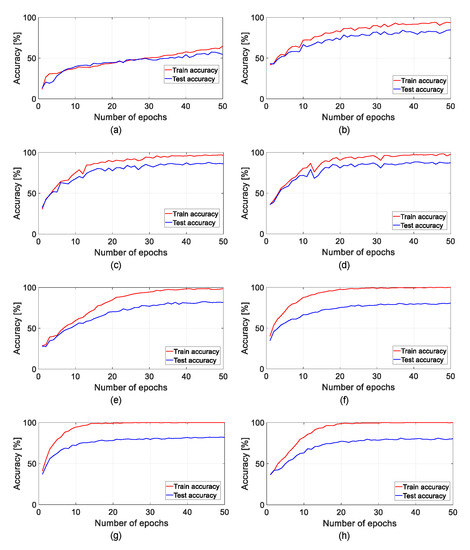
Figure 14.
Accuracy vs. number of epochs of 8 networks: (a) LeNet-5. (b) AlexNet. (c) VGG 11. (d) VGG 19. (e) Inception V3. (f) ResNet 18. (g). Resnet 34. (h) ResNet 50.
The quantitative assessment is represented in Table 6. The VGG-19 attains the highest accuracy on the testing set, while the LeNet-5 model gives the lowest accuracy on the testing set. It is worth noticing that three ResNet models are overfitting as their accuracies are 100%.

Table 6.
Accuracy of eight models on the training and testing sets at the 50th epoch.
As the VGG-19 model achieves the best performance on the 1842 sample images, this model is utilized to estimate the ratio of two short-circuit currents in four case studies. Table 7 presents the results of estimating the ratio of short-circuit currents in four case studies. The estimated values are expressed in form of the mean value of the classification range. The estimated ratios are reasonable with the patterns of the PSC on the PV array. In case 1, two panels in the first row have lower ratios (0.35), while two panels in the second row have a higher ratio (0.95). In case 2 and case 3, the difference between two panels in the first row and two panels in the second is not significant. Panel 1 and panel 2 have a ratio of 0.45, while the ones of panel 3 and panel 4 are 0.45. In case 4, panel 1 and panel 2 have the estimated ratios of the short-circuit currents of 0.95. The ratio of the short-circuit current of panel 3 is also high (0.75), while the one of panel 4 is low (0.45). These estimated values are used to decide switching patterns for the PV array under each shading case.

Table 7.
Estimation of ratio of short-circuit currents in four case studies.
5.2.2. Output Power of Proposed Dynamic PVAR
The estimated ratios of two short-circuit currents in the previous section are used to decide the new configuration for the PV array under four shading patterns. Figure 15 shows the average value of the difference between the ratios of the short-circuit current of the PV array before and after reconfiguration. The new configuration is obtained by the Best-worst algorithm [29]. After the reconfiguration, the differences in the ratios of two short-circuit currents are all reduced. In case 1 and case 4, the efficacy of the proposed Dynamic PVAR is most powerful in case 1 since the is reduced from 0.6 to 0 and second powerful in case 4 from 0.35 to 0.15. In case 2 and case 3, the PV arrays after reconfiguration all have the improvement of from 0.1 to 0.
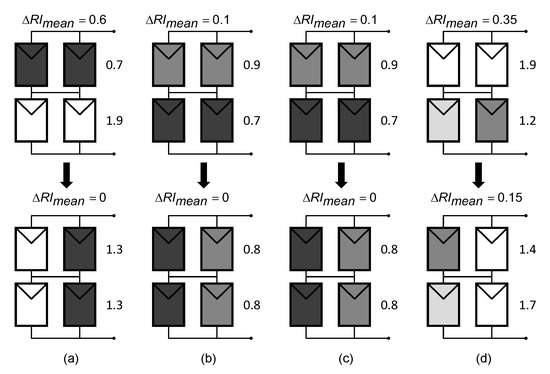
Figure 15.
P–V array before and after reconfiguration: (a) Case 1. (b) Case 2. (c) Case 3. (d) Case 4.
Figure 16 shows the P–V characteristics of the PV array without PSC, with PSC before deploying the proposed Dynamic PVAR, and with PSC after using the proposed Dynamic PVAR in four case studies. In case 1 (Figure 16a), the MPP of the P–V curve (black curve) without being shaded is much higher than that of the P–V curve under PSC before deploying the proposed Dynamic PVAR (red curve). After using the proposed Dynamic PVAR (blue curve), the MPP of the curve is notably improved. In case 2 and case 3 (Figure 16b,c), the difference between the MPP before and after applying the proposed Dynamic PVAR is not significant as the one in case 1. In case 2 and case 3, before the reconfiguration, the differences between the mean values of ratios of the short-circuit currents of the first row and the second row have not significant. It means that the effect of PSC on the PV array is evenly distributed on two rows of the PV array. In addition, the output voltage of the PV array is trivially affected by the irradiance. Therefore, the output current/power of the shaded module changes insignificantly after reconfiguration. In case 4 (Figure 16d), the MPP of the PV array is considerably improved. This is thanks to the differences between the ratios of the first and the second row of the PV array is reduced after the reconfiguration.

Figure 16.
P–V curves of PV array under PSC: (a) Case 1. (b) Case 2. (c) Case 3. (d) Case 4.
The quantitative comparisons are demonstrated in Figure 17 and Figure 18. In Figure 17, the GMPP of the PV array without PSC, with PSC and before switching, and with PSC and after switching. The GMPP of the PV array substantially reduced after being shaded as the paper boards prevent almost all the irradiance fluxing on the PV modules. In all cases, the GMPPs are improved after switching. In Figure 18a, the power improvements are substantially enhanced in case 1 (22.08%) and case 4 (25.19%). In case 2 and case 3, the power is relatively enhanced to 5.81% and 9.63%, respectively. In the same token, the power losses are most minimized in case 1 and case 2. In Figure 18b, the power losses are reduced significantly in case 4 (13.75%) and case 1 (9.53%) after applying the proposed reconfiguration. In case 2 and case 3, the power losses are slightly reduced. These reduction of power losses are justifiable with the difference in the ratios of the short-circuit currents in the PV array in four cases.
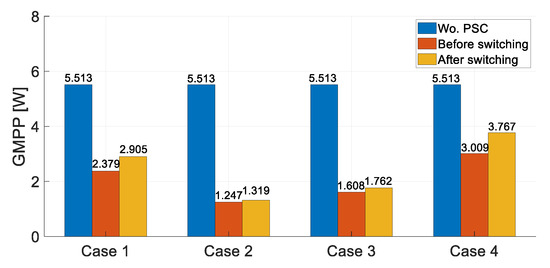
Figure 17.
GMPP of proposed Dynamic PVAR in four studied cases.

Figure 18.
Performance metrics of proposed Dynamic PVAR in four studied cases: (a) Power improvement. (b) Reduction of Power loss.
Figure 19 illustrates the output voltage, current, and power of the PV array under four cases. The PV array is under five operational stages. First, the PV array is under the uniform irradiance condition (blue region), which is the state without PSC. After that, it takes about 50 to 100 s to set up the partial shading on the PV array (gray region). Then, the shading lasts around 15 s (pink region). The time to track the MPP might be required depending on the cases (yellow region). Finally, the PV array is under a new configuration (green region). In case 1 (Figure 19a), the voltage at the MPP under uniform condition and reconfigured condition are around 13 V, specifically the voltage at the MPP of the reconfigured PV array is slightly higher than that of the initial PV array. Whereas, the voltage at the MPP of the shaded PV array is smaller, around 7V. Therefore, although the current at the MPP of the shaded PV array is higher than that of the initial PV array and the reconfigured PV array, its power is the smallest one. In case 2, the voltage at the MPP of the shaded and the reconfigured is the same, therefore it is not required to track the new MPPT. The output power of the reconfigured PV array is greater than that of the shaded PV array. Although the power improvement after using the proposed Dynamic PVAR is not significant as the one in case 1, this is reasonable as the shade is already distributed relatively even before switching. In case 3, while the voltage at the MPPT of the reconfigured PV array is smaller than that of the shaded PV array, the reconfigured current at the MPPT is greater than the shaded current at the MPPT. The output power of the PV array is improved after being reconfigured. In case 4, the shaded voltage at the MPPT is much smaller than the reconfigured voltage at the MPPT. The output power is enhanced considerably after reconfiguration. In summary, the output power of the reconfigured PV array is higher than the one of the shaded PV array in all four case studies, which shows the effectiveness of the proposed Dynamic PVAR. It is worth mentioning that in our experiment the transition between two MPP are performed manually. That is the reason why the MPPT time are relatively long in cases 1, 3, and 4. In practical, the MPP is changed automatically with the help of MPPT tracker.
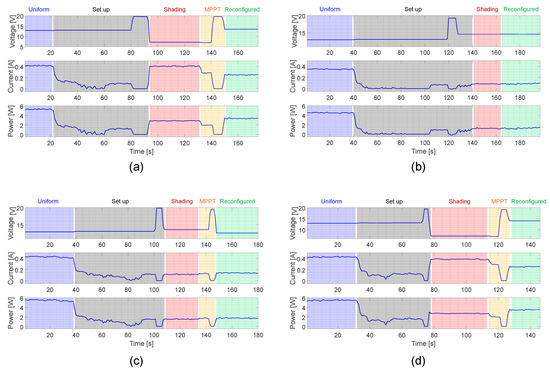
Figure 19.
Output of PV array under PSC: (a) Case 1. (b) Case 2. (c) Case 3. (d) Case 4.
6. Conclusions
The PSC has a deleterious effects on PV arrays, including diminishing the output power and degrading the lifetime of the PV panels. To address this challenge, the Dynamic PVAR is intensively studied. In this paper, a new approach to define the optimal configuration is proposed based on evaluating the effect of the PSC on the short-circuit current. The proposed method resolves the difficulties of measuring the irradiance for each PV module. The CNN-based models are developed to estimate the ratio of short-circuit currents based on the images of the PV array, which is used as a new indicator to decide switching patterns. The VGG 19-based model gives the best estimating result with the MAPE of 3.75%, and RMSE of 0.0513 corresponding to the accuracy of 88.47%. The CNN-based model to estimate the ratio of the short-circuit currents helps to eliminate the expensive pyranometers and consider the shading effect on the irradiance of the PV module. The proposed Dynamic PVAR framework improves the output power in four shading cases. In case 4, the output power is substantially boosted to 25.19%, and the power losses are reduced to 13.75%. The experimental results have validated the effectiveness of the proposed Dynamic PVAR framework in enhancing the output power of the PV array under PSC.
Author Contributions
T.N.-D.: Conceptualization, Methodology, Resources, Project administration, Supervision, Funding acquisition, Writing—Reviewing and Editing. T.L.-V.: Conceptualization, Methodology, Formal analysis, Writing—Original draft preparation, Experiment, Software, Visualization, Investigation. D.N.-D.: Methodology, Formal analysis, Software, Writing—Original draft preparation, Experiment, Data curation, Visualization, Investigation. T.D.-Q.: Experiment, Data curation. M.B.-Q.: Experiment, Data curation. All authors have read and agreed to the published version of the manuscript.
Funding
This research is funded by the Hanoi University of Science and Technology (HUST) under project number T2020-SAHEP-005.
Conflicts of Interest
The authors declare no conflict of interest.
References
- IEA. Task 1 Strategic PV Analysis and Outreach—2021 Snapshot of Global PV Markets; IEA: Indianapolis, IN, USA, 2020; pp. 1–16. Available online: www.Iea-Pvps.Org (accessed on 14 July 2022).
- Shmilovitz, D.; Levron, Y. Distributed Maximum Power Point Tracking in Photovoltaic Systems—Emerging Architectures and Control Methods. Automatika 2012, 53, 142–155. [Google Scholar] [CrossRef]
- Malathy, S.; Ramaprabha, R. Performance enhancement of partially shaded solar photovoltaic array using grouping technique. J. Sol. Energy Eng. Trans. ASME 2015, 137, 34505. [Google Scholar] [CrossRef]
- Yang, B.; Ye, H.; Wang, J.; Li, J.; Wu, S.; Li, Y.; Shu, H.; Ren, Y.; Ye, H. PV arrays reconfiguration for partial shading mitigation: Recent advances, challenges and perspectives. Energy Convers. Manag. 2021, 247, 114738. [Google Scholar] [CrossRef]
- Chavan, V.C.; Mikkili, S. Effect of PV Array Positioning on Mismatch and Wiring Losses in Static Array Reconfiguration. IETE J. Res. 2021, 1–14. [Google Scholar] [CrossRef]
- Chavan, V.C.; Mikkili, S.; Senjyu, T. Hardware Implementation of Novel Shade Dispersion PV Reconfiguration Technique to Enhance Maximum Power under Partial Shading Conditions. Energies 2022, 15, 3515. [Google Scholar] [CrossRef]
- Sai Krishna, G.; Moger, T. Optimal SuDoKu Reconfiguration Technique for Total-Cross-Tied PV Array to Increase Power Output under Non-Uniform Irradiance. IEEE Trans. Energy Convers. 2019, 34, 1973–1984. [Google Scholar] [CrossRef]
- Yadav, K.; Kumar, B.; Swaroop, D. Mitigation of Mismatch Power Losses of PV Array under Partial Shading Condition using novel Odd Even Configuration. Energy Rep. 2020, 6, 427–437. [Google Scholar] [CrossRef]
- Mishra, N.; Yadav, A.S.; Pachauri, R.; Chauhan, Y.K.; Yadav, V.K. Performance enhancement of PV system using proposed array topologies under various shadow patterns. Solar Energy 2017, 157, 641–656. [Google Scholar] [CrossRef]
- Anjum, S.; Mukherjee, V.; Mehta, G. Modelling and simulation of AdDoKu based reconfiguration technique to harvest maximum power from photovoltaic array under partial shading conditions. Simul. Model. Pract. Theory 2022, 115, 102447. [Google Scholar] [CrossRef]
- Babu, T.S.; Yousri, D.; Balasubramanian, K. Photovoltaic Array Reconfiguration System for Maximizing the Harvested Power Using Population-Based Algorithms. IEEE Access 2020, 8, 109608–109624. [Google Scholar] [CrossRef]
- Yang, B.; Shao, R.; Zhang, M.; Ye, H.; Liu, B.; Bao, T.; Wang, J.; Shu, H.; Ren, Y.; Ye, H. Socio-inspired democratic political algorithm for optimal PV array reconfiguration to mitigate partial shading. Sustain. Energy Technol. Assess. 2021, 48, 101627. [Google Scholar] [CrossRef]
- Sai Krishna, G.; Moger, T. A novel adaptive dynamic photovoltaic reconfiguration system to mitigate mismatch effects. Renew. Sustain. Energy Rev. 2021, 141, 110754. [Google Scholar] [CrossRef]
- Sugumar, S.; Prince Winston, D.; Pravin, M. A novel on-time partial shading detection technique for electrical reconfiguration in solar PV system. Solar Energy 2021, 225, 1009–1025. [Google Scholar] [CrossRef]
- Kumar Pachauri, R.; Thanikanti, S.B.; Bai, J.; Kumar Yadav, V.; Aljafari, B.; Ghosh, S.; Haes Alhelou, H. Ancient Chinese magic square-based PV array reconfiguration methodology to reduce power loss under partial shading conditions. Energy Convers. Manag. 2022, 253, 115148. [Google Scholar] [CrossRef]
- Karmakar, B.K.; Karmakar, G. A Current Supported PV Array Reconfiguration Technique to Mitigate Partial Shading. IEEE Trans. Sustain. Energy 2021, 12, 1449–1460. [Google Scholar] [CrossRef]
- Aidha, M.; Ajmal, V.K. Ramachandaramurthy, A.T.J.B.E. Optimal dynamic reconfiguration of large-scale PV plant under partial shading conditions based on two reconfigurable stages. Int. Trans. Electr. Energy Syst. 2021, 31, e12746. [Google Scholar] [CrossRef]
- Durango-Flórez, M.; González-Montoya, D.; Trejos-Grisales, L.A.; Ramos-Paja, C.A. PV Array Reconfiguration Based on Genetic Algorithm for Maximum Power Extraction and Energy Impact Analysis. Sustainability 2022, 14, 3764. [Google Scholar] [CrossRef]
- Rani, B.I.; Ilango, G.S.; Nagamani, C. Enhanced power generation from PV array under partial shading conditions by shade dispersion using Su Do Ku configuration. IEEE Trans. Sustain. Energy 2013, 4, 594–601. [Google Scholar] [CrossRef]
- Velasco-Quesada, G.; Guinjoan-Gispert, F.; Piqué-López, R.; Román-Lumbreras, M.; Conesa-Roca, A. Electrical PV array reconfiguration strategy for energy extraction improvement in grid-connected PV systems. IEEE Trans. Ind. Electron. 2009, 56, 4319–4331. [Google Scholar] [CrossRef]
- Babu, T.S.; Ram, J.P.; Dragičević, T.; Miyatake, M.; Blaabjerg, F.; Rajasekar, N. Particle swarm optimization based solar PV array reconfiguration of the maximum power extraction under partial shading conditions. IEEE Trans. Sustain. Energy 2018, 9, 74–85. [Google Scholar] [CrossRef]
- Cavieres, R.; Barraza, R.; Estay, D.; Bilbao, J.; Valdivia-Lefort, P. Automatic soiling and partial shading assessment on PV modules through RGB images analysis. Appl. Energy 2022, 306, 117964. [Google Scholar] [CrossRef]
- Le, M.; Van Su, L.; Dang Khoa, N.; Dao, V.D.; Ngoc Hung, V.; Hong Ha Thi, V. Remote anomaly detection and classification of solar photovoltaic modules based on deep neural network. Sustain. Energy Technol. Assess. 2021, 48, 101545. [Google Scholar] [CrossRef]
- Wang, X.; Yang, W.; Qin, B.; Wei, K.; Ma, Y.; Zhang, D. Intelligent monitoring of photovoltaic panels based on infrared detection. Energy Rep. 2022, 8, 5005–5015. [Google Scholar] [CrossRef]
- Bouselham, L.; Rabhi, A.; Hajji, B.; Mellit, A. Photovoltaic array reconfiguration method based on fuzzy logic and recursive least squares: An experimental validation. Energy 2021, 232, 121107. [Google Scholar] [CrossRef]
- Matam, M.; Barry, V.R. Improved performance of Dynamic Photovoltaic Array under repeating shade conditions. Energy Convers. Manag. 2018, 168, 639–650. [Google Scholar] [CrossRef]
- Pachauri, R.; Singh, R.; Gehlot, A.; Samakaria, R.; Choudhury, S. Experimental analysis to extract maximum power from PV array reconfiguration under partial shading conditions. Eng. Sci. Technol. Int. J. 2019, 22, 109–130. [Google Scholar] [CrossRef]
- Pendem, S.R.; Mikkili, S. Modelling and performance assessment of PV array topologies under partial shading conditions to mitigate the mismatching power losses. Solar Energy 2018, 160, 303–321. [Google Scholar] [CrossRef]
- Storey, J.P.; Wilson, P.R.; Bagnall, D. Improved Optimization Strategy for Irradiance Equalization in Dynamic Photovoltaic Arrays. IEEE Trans. Power Electron. 2013, 28, 2946–2956. [Google Scholar] [CrossRef]
- Geron, A. Hands-on Machine Learning with Scikit-Learn and TensorFlow: Concepts, Tools, and Techniques to Build Intelligent Systems; O’Reilly Media: Sebastopol, CA, USA, 2017. [Google Scholar]
- Zhang, A.; Lipton, Z.C.; Li, M.; Smola, A.J. Dive into Deep Learning. arXiv 2021, arXiv:2106.11342. [Google Scholar]
- Dutta, A.; Zisserman, A. The VIA annotation software for images, audio and video. In Proceedings of the MM 2019000Proceedings of the 27th ACM International Conference on Multimedia, Nice, France, 21–25 October 2019; pp. 2276–2279. [Google Scholar] [CrossRef]
- Lecun, Y.; Bottou, L.; Bengio, Y.; Haffner, P. Gradient-based learning applied to document recognition. Proc. IEEE 1998, 86, 2278–2324. [Google Scholar] [CrossRef] [Green Version]
- Krizhevsky, A.; Sutskever, I.; Hinton, G.E. ImageNet Classification with Deep Convolutional Neural Networks. In Advances in Neural Information Processing Systems; Pereira, F., Burges, C., Bottou, L., Weinberger, K., Eds.; Curran Associates, Inc.: Red Hook, NY, USA, 2012; Volume 25. [Google Scholar]
- Simonyan, K.; Zisserman, A. Very deep convolutional networks for large-scale image recognition. In Proceedings of the 3rd International Conference on Learning Representations, ICLR 2015—Conference Track Proceedings, San Diego, CA, USA, 7–9 May 2015; pp. 1–14. [Google Scholar]
- Szegedy, C.; Vanhoucke, V.; Ioffe, S.; Shlens, J.; Wojna, Z. Rethinking the Inception Architecture for Computer Vision. In Proceedings of the IEEE Computer Society Conference on Computer Vision and Pattern Recognition, Las Vegas, NV, USA, 27–30 June 2016; pp. 2818–2826. [Google Scholar] [CrossRef]
- Szegedy, C.; Liu, W.; Jia, Y.; Sermanet, P.; Reed, S.; Anguelov, D.; Erhan, D.; Vanhoucke, V.; Rabinovich, A. Going deeper with convolutions. In Proceedings of the IEEE Computer Society Conference on Computer Vision and Pattern Recognition, Boston, MA, USA, 7–12 June 2015; pp. 1–9. [Google Scholar] [CrossRef]
- He, K.; Zhang, X.; Ren, S.; Sun, J. Deep residual learning for image recognition. In Proceedings of the IEEE Computer Society Conference on Computer Vision and Pattern Recognition, Las Vegas, NV, USA, 27–30 June 2016; pp. 770–778. [Google Scholar] [CrossRef] [Green Version]
Publisher’s Note: MDPI stays neutral with regard to jurisdictional claims in published maps and institutional affiliations. |
© 2022 by the authors. Licensee MDPI, Basel, Switzerland. This article is an open access article distributed under the terms and conditions of the Creative Commons Attribution (CC BY) license (https://creativecommons.org/licenses/by/4.0/).